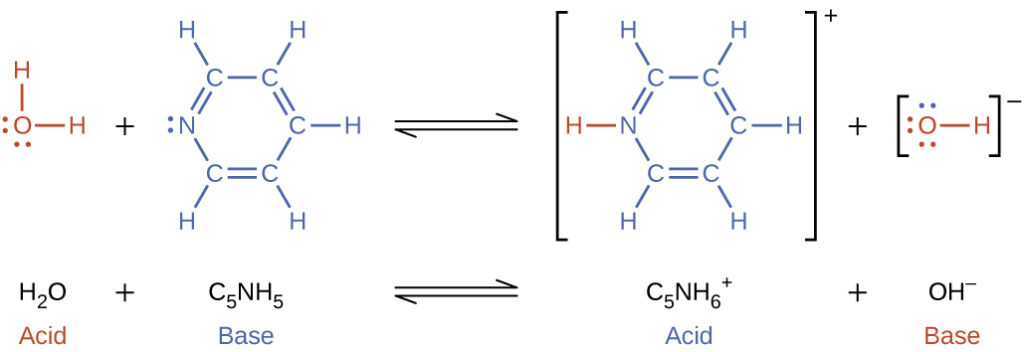The properties of acids and bases have been studied since the earliest history of science and chemistry, and we have refined our definitions many times as our knowledge evolved.
Since the early 1800s, chemists have understood that hydrogen was an essential component of acids, leading to the Arrhenius definition of acids as a compound that dissolves in water to yield hydrogen cations, H+ (now recognized to be hydronium ions, H3O+) and bases as compounds that dissolve in water to yield hydroxide anions OH–. Note that the hydrogen ions released by acids are often referred to simply as protons, since that subatomic particle is the only component of cations derived from the most abundant hydrogen isotope, 1H.
Johannes Brønsted and Thomas Lowry proposed a more general description in which acids and bases were defined in terms of the transfer of hydrogen ions, H+. A compound that donates a proton to another compound is called a Brønsted-Lowry acid, and a compound that accepts a proton is called a Brønsted-Lowry base. An acid-base reaction is, thus, the transfer of a proton from a donor (acid) to an acceptor (base).
Conjugate acid-base pairs
The concept of conjugate pairs is useful in describing Brønsted-Lowry acid-base reactions (and other reversible reactions, as well). When an acid donates H+, the species that remains is called the conjugate base of the acid because it reacts as a proton acceptor in the reverse reaction. Likewise, when a base accepts H+, it is converted to its conjugate acid. The reaction between water and ammonia illustrates this idea. In the forward direction, water acts as an acid by donating a proton to ammonia and subsequently becoming a hydroxide ion, OH−, the conjugate base of water. The ammonia acts as a base in accepting this proton, becoming an ammonium ion, $NH_4 ^+$ the conjugate acid of ammonia. In the reverse direction, a hydroxide ion acts as a base in accepting a proton from ammonium ion, which acts as an acid.

The reaction between a Brønsted-Lowry acid and water is called acid ionization. For example, when hydrogen fluoride dissolves in water and ionizes, protons are transferred from hydrogen fluoride molecules to water molecules, yielding hydronium ions and fluoride ions:

Base ionization of a species occurs when it accepts protons from water molecules. In the example below, pyridine molecules, C5NH5, undergo base ionization when dissolved in water, yielding hydroxide and pyridinium ions:

The preceding ionization reactions suggest that water may function as both a base (as in its reaction with hydrogen fluoride) and an acid (as in its reaction with ammonia). Species capable of either donating or accepting protons are called amphiprotric, or more generally, amphoteric, a term that may be used for acids and bases per definitions other than the Brønsted-Lowry one. The equations below show the two possible acid-base reactions for two amphiprotic species, bicarbonate ion and water:
$$HCO_3^-\;(aq)+H_2O\;(l)⇌CO_3^{2-}\;(aq)+H_3O^+\;(aq)$$ $$HCO_3^-\;(aq)+H_2O\;(l)⇌H_2CO_3\;(aq)+OH^-\;(aq)$$The first equation represents the reaction of bicarbonate as an acid with water as a base, whereas the second represents reaction of bicarbonate as a base with water as an acid. When bicarbonate is added to water, both these equilibria are established simultaneously and the composition of the resulting solution may be determined through appropriate equilibrium calculations, as described later in this chapter.